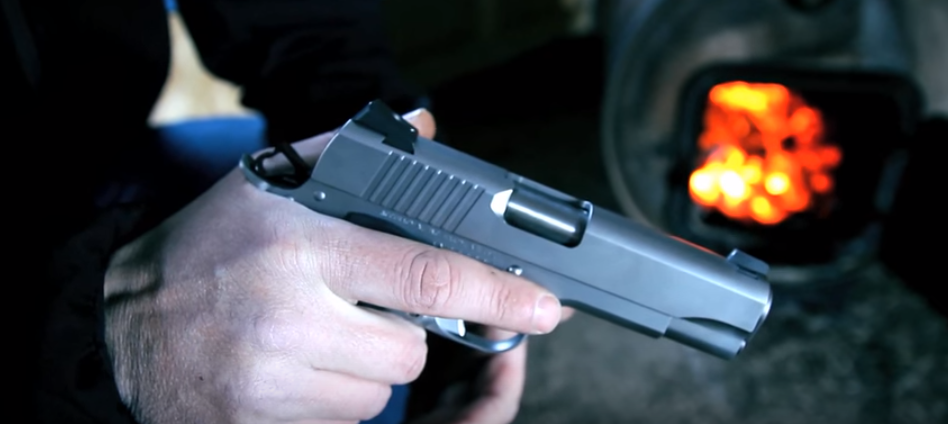
Ruger 9mm Compact Pistol
With the introduction of the American Pistol Compact, Ruger’s line of Patently Patriotic Firearms expands and shrinks at the same time.
STORY AND PHOTOS BY BRAD FITZPATRICK
Bill Ruger would have turned 104 years old in 2020, and even though he is gone I believe that he would have been quite impressed with the innovative firearm designs that continue to appear on pages of his namesake company’s annual catalog. Unlike Colt, Smith & Wesson, Remington and Winchester, which were all operating in the 1800s, the Ruger brand is relatively new. But in just over 60 years, Ruger guns have earned a spot near the top of all American gun manufacturers. In firearms manufacturing terms that’s a meteoric rise, and it doesn’t seem to be slowing.

The American Compact enters the most competitive arena in gundom, and is the most recent combatant in the fierce battle for carry-gun supremacy. And while Glock may have brought life to the polymer frame/striker-fire gun category, they are hardly the only game in town anymore. Virtually every major handgun manufacturer has some sort of gun that fits this mold, and more are coming.

For the past few years, Ruger has launched several products under the American name (which is fitting, since these guns are made in the U.S.), most recently adding the American Pistol to round out their patriotically themed rimfire and centerfire rifle families. The Ruger American is a polymer-framed, striker-fired semiauto available in 9mm and .45. It offers many of the same features you’ll find on competing guns, such as interchangeable grips, a bladed trigger, and an accessory rail tucked under the gun’s muzzle. The price is one that any hard-working American can afford: $579 MSRP, with lower prices around for bargain shoppers.

The standard American has a 4.2-inch barrel in 9mm and a 4.5-inch pipe in .45. With a full magazine, the 9mm version offers an impressive 17+1-round capacity, and while the gun is great fun at the range, it’s a bit big to break into the main channel of the concealed carry market.
GET IT HERE
But Ruger was one step ahead, planning (and now offering) a compact version of the American semiauto pistol.
It’s not as though Ruger needed another compact gun, truthfully. This is, after all, the brand that brought us the LCP and LCP II, LC380, LC9s, SR9/SR40C, and they also now offer a 1911 Commander as well. But the concealed carry market continues to grow, and having a full portfolio never hurts, so they have added the American Pistol Compact to that mix.
THE 9MM COMPACT VERSION of the American (the full-sized model is called the Duty) sports a 3.55-inch barrel (3.75inch in .45) with a length of just 6.65 inches. Designing a carry gun is always a give and take with regard to overall size; small guns are easy to hide and carry, but they aren’t as comfortable to shoot or as accurate (in most cases) as larger, longer-barreled guns. The American Duty pistol is a very comfortable gun to shoot at the range, with great sights and an excellent trigger that mate well with its grip geometry and control layout. But it’s big; too big for most people to carry.


The Compact, on the other hand, does a great job balancing on that middle ground that makes it just the right size for everyday concealment. It weighs right around 29 ounces (a little more or less depending upon whether or not you opt for a manual safety) and measures – again depending on your safety option – just under or over an inch and a half wide at the controls. It utilizes a double-stack magazine that gives you 12 shots in 9mm, unless you live some place that forbids that amount of firepower, in which case you’ll be deducted a couple shots.
Concealed carry is indeed a numbers game, and the American Compact has the data required to be a serious player. But to do a proper evaluation on any carry gun, we need to take a close look at all the features and see how they stack up against the competition.
Dead Foot Arms
I put about 200 rounds of 9mm ammo through the American Compact I was testing, and although it’s hardly torturing the gun, that many rounds offers plenty of feedback on what this gun will do. I used three different loads for the test – Hornady’s American Gunner with 115-grain XTP bullets, SIG Sauer’s 124-grain Elite Performance V-Crown, and Nosler’s Defense Bonded Performance 124-grain +P load. It wasn’t any accident that I chose these loads, either, for they’ve all proven to be effective and accurate, and I’d stake my life on any of them.

There are some striker-fired semiauto carry guns that seem to eat anything you feed them, and the Compact is one of them. I fed it magazine after magazine, fired from the bench at 15 yards and from standing and kneeling positions. I did draws, drills, and double-taps, all in an effort to see if this gun runs. And, in fact, it does. It feeds nicely, the magazine is well built and easy to use with springs that function well but don’t exhaust the hands when loading (if your mitts do get tired, there’s a mag loading tool included with the gun, though).
In 205 rounds tested there were 205 proper feeds, proper extractions, and proper ejections. The only inconsistency was that the slide didn’t stay open once, but when you’re talking about roughly 40 magazine changes over the course of the test I don’t consider that an issue. In short, the American Compact will function well with good loads. It isn’t particularly finicky, and it functions well.
I PLACE CONTROL DESIGN AND LAYOUT near the top of my priority list when evaluating a carry gun. Over the course of the last decade, controls on carry guns have been consistently shrinking – in some cases, disappearing altogether – with the idea being that fewer controls are less likely to hang up when drawing and less confusing when shooting. I suppose that there’s some validity to this, but I’ve drawn dozens and dozens of test guns over that same time period and I have yet to have a slide stop or safety hang-up when I was doing my part. What I have had happen – and what seems to happen with some regularity – is that I have tested striker-fired guns with such Lilliputian controls that I have to fuss with a teeny tiny slide stop during a reload.

I offer this lengthy thought to laud praise on the American Compact. I tested the version with an ambidextrous manual safety in large part because a lot of people who carry concealed want a manual safety (if you just rolled your eyes, there’s a version called the Pro Model for you). At its most basic level, the Ruger’s safety operates like that of a 1911 in as much as you press the lever down to fire and elevate it to activate. It’s fairly narrow but easy to find and manipulate, a good combination on a carry gun. There’s no fiddling with a tiny, heavy button – one swipe of the thumb and you’re ready.
The ambidextrous slide stop is fairly small but functional and, like the safety, shouldn’t hang when drawing. The takedown lever remains tucked out of the way on the front of the frame, but it makes disassembly a cinch. A subtle depression and polymer bump keep the shooting hand thumb in place, and just below that you’ll find the triangular magazine release button. If you choose the Pro Model and eliminate the manual safety, it’s a clean but functional control landscape, and even with the safety lever this gun is easy to holster, draw and hide.
Triggers on striker-fired guns range from pretty good to terribly sloppy, and you simply can’t expect the same performance you’ll get from a single action. That being said, the Ruger trigger is on solidly the plus side of striker guns. There’s a good deal of take-up and the trigger breaks at 6 pounds, but the reset is positive and short, so you can deliver fast follow-ups.

THIS GUN IS MEANT TO BE CARRIED, so for eight days the Ruger was my traveling companion just about everywhere I went. I tested it with Versacarry’s new Commander OWB and Quick Slide OWB/IWB holsters, opting for the Commander when I was wearing a jacket or wasn’t as concerned about concealing the gun and switching to the Quick Slide when I wanted to be sure the gun was out of sight.
The double-stack magazine makes the American Compact slightly wider than the ultrathin single stacks from Ruger and others, but with a maximum width of just 1½ inches with the manual safety this gun isn’t terrible hard to conceal, and at 30 ounces it rides well in both holsters without the need for a really heavy belt. It’s also worth noting that the grip angle promotes a positive, high grip when drawing the gun, so it’s easy to be consistent when engaging a target.

There are two options for magazines; one with a flat bottom and another with a finger extension. Measuring 5¼ inches from top to bottom with the finger extension magazine installed, the gun is compact enough that you could easily carry with either mag. In fact, I carried with the finger extension in place the whole time and never had any issues with printing, although it was winter and I wore a light jacket almost everywhere I went. As previously mentioned, Ruger built this gun with specifications that allow it to be carried relatively easily (though it won’t vanish under light clothing like the LCP II), yet it’s fun to shoot at the range.

Sometimes shooting a compact pistol on the range is a real chore; recoil can be excessive when shooting ultralight pistols with narrow grips coupled with hot defensive loads. The American Compact is much more subdued, feeling (at least with the finger extension magazine, which you’ll probably using at the range anyway) more like a midsized pistol – Ruger’s American Duty or SR9, a Glock 19/17 or Walther PPQ – than a single-stack ultracompact 9mm. The three rounds tested performed well (see chart) and groups around 1½ inches were the norm when fired from 15 feet off the bench while using sand bags.

But the real test for this gun was how it handled off the bench, and it performed quite well when delivering double-taps, performing lateral and horizontal movement drills, and when drawing and firing. The trigger, as previously mentioned, has a short reset, and that high grip and a relatively low bore axis helps keeps recoil manageable for quick follow-ups. Those Novak sights are a nice touch, too, and even in dim light or with poor eyesight you’ll be able to see the white dots.
The American comes with three easily interchangeable grips, so if you want to change the feel of the gun, it’s easy to do. There’s also a Picatinny rail, so if you want to add a laser or light that won’t be a problem either.
In closing, the Ruger American Compact is a great gun for those who appreciate its simple-to-use design, good trigger and reliable engineering. It’s a crowded and tough market out there, but the American deserves a spot on your short list when comparing 9mm carry guns. AmSJ





